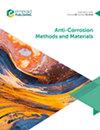Experimental and computational study of imidazole-pyridine and its derivatives as corrosion inhibitors on brass in sulfuric acid solution
IF 2.6
4区 材料科学
Q2 METALLURGY & METALLURGICAL ENGINEERING
引用次数: 0
Abstract
Purpose This paper aims to study the corrosion inhibition behavior of imidazopyridine and its three derivatives on brass. Design/methodology/approach The authors performed weight loss experiments, electrochemical experiments including the polarization curve and electrochemical impedance spectrum, corrosion morphology observation using scanning electron microscope (SEM) and atomic force microscope (AFM) and surface composition analysis via X-ray photoelectron spectroscopy (XPS) to analyze the corrosion inhibition behavior of imidazopyridine and its three derivatives on brass by using quantum chemical calculation (Gaussian 09), molecular dynamics simulation (M-S) and Langmuir adsorption isotherm. Findings According to the results, imidazole-pyridine and its derivatives were found to be modest or moderately mixed corrosion inhibitors; moreover, they were spontaneously adsorbed on the metal surface in a single-layer, mixed adsorption mode. Originality/value The corrosion inhibition properties of pyrazolo-[1,2-a]pyridine and its derivatives on brass in sulfuric acid solution were analyzed through weight loss and electrochemical experiments. Moreover, SEM and AFM were simultaneously used to observe the corrosion appearance. Furthermore, XPS was used to analyze the surface. Then, Gaussian 09 and M-S were combined along with the Langmuir adsorption isotherm to investigate the corrosion inhibition mechanism of imidazole-[1,2-a]pyridine and its derivatives.咪唑吡啶及其衍生物在硫酸溶液中作为黄铜缓蚀剂的实验与计算研究
目的研究咪唑吡啶及其衍生物对黄铜的缓蚀行为。设计/方法/方法作者进行了失重实验,电化学实验包括极化曲线和电化学阻抗谱,采用扫描电镜(SEM)和原子力显微镜(AFM)进行腐蚀形貌观察,x射线光电子能谱(XPS)进行表面成分分析,采用量子化学计算(高斯09)、分子动力学模拟(M-S)和Langmuir吸附等温线分析咪唑吡啶及其3个衍生物对黄铜的缓蚀行为。结果表明,咪唑吡啶及其衍生物为中度或中度混合缓蚀剂;此外,它们以单层混合吸附模式自发吸附在金属表面。通过失重实验和电化学实验,分析了吡唑啉-[1,2-a]吡啶及其衍生物在硫酸溶液中对黄铜的缓蚀性能。同时利用扫描电镜和原子力显微镜对腐蚀形貌进行了观察。利用XPS对样品表面进行了分析。然后将高斯09和M-S结合Langmuir吸附等温线研究咪唑-[1,2-a]吡啶及其衍生物的缓蚀机理。
本文章由计算机程序翻译,如有差异,请以英文原文为准。
求助全文
约1分钟内获得全文
求助全文
来源期刊

Anti-corrosion Methods and Materials
工程技术-冶金工程
CiteScore
2.80
自引率
16.70%
发文量
61
审稿时长
13.5 months
期刊介绍:
Anti-Corrosion Methods and Materials publishes a broad coverage of the materials and techniques employed in corrosion prevention. Coverage is essentially of a practical nature and designed to be of material benefit to those working in the field. Proven applications are covered together with company news and new product information. Anti-Corrosion Methods and Materials now also includes research articles that reflect the most interesting and strategically important research and development activities from around the world.
Every year, industry pays a massive and rising cost for its corrosion problems. Research and development into new materials, processes and initiatives to combat this loss is increasing, and new findings are constantly coming to light which can help to beat corrosion problems throughout industry. This journal uniquely focuses on these exciting developments to make essential reading for anyone aiming to regain profits lost through corrosion difficulties.
• New methods, materials and software
• New developments in research and industry
• Stainless steels
• Protection of structural steelwork
• Industry update, conference news, dates and events
• Environmental issues
• Health & safety, including EC regulations
• Corrosion monitoring and plant health assessment
• The latest equipment and processes
• Corrosion cost and corrosion risk management.
 求助内容:
求助内容: 应助结果提醒方式:
应助结果提醒方式:


